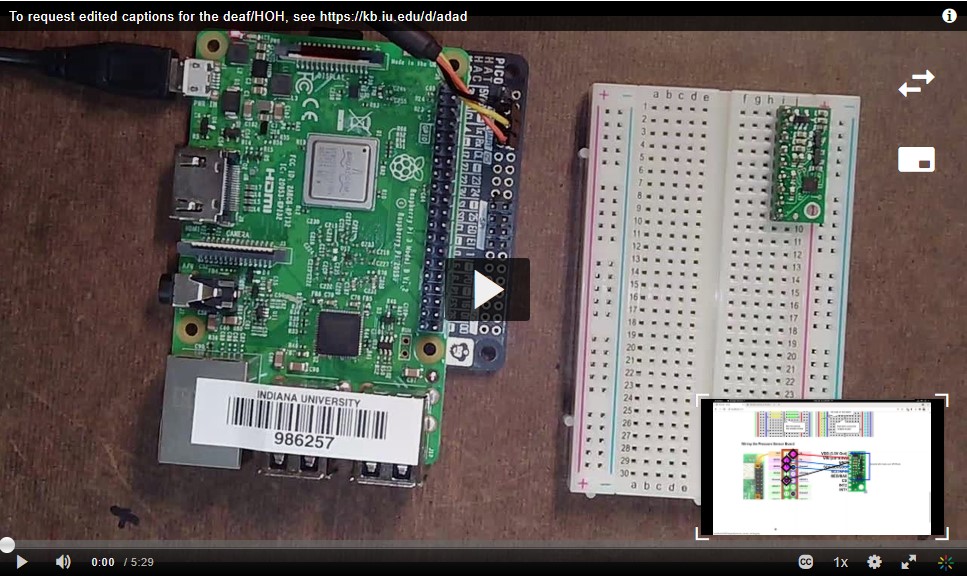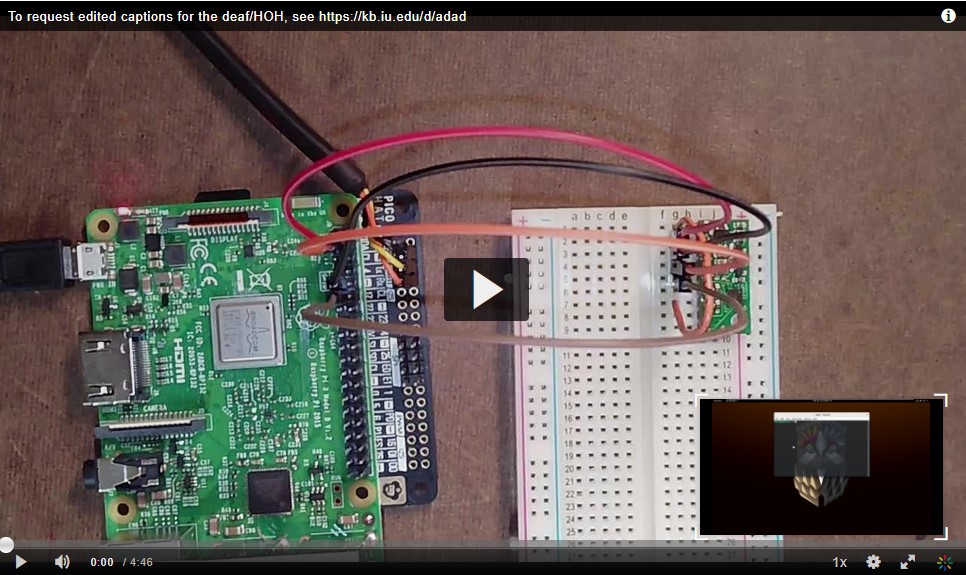ENGR210
I2C Introduction
Due: Sunday, January 26th
You are in the process of creating a cyber-physical system that will allow you to interact with sensors from a network. As a reminder, this is the full system block diagram. You should now what the ability to talk to your board both through the UART interface and the wireless network interface.

Project 1
Overview
In this project, you will be extending your base Raspberry Pi system to include a pressure and temperature sensor. The pressure and temperature sensors are in the same integrated circuit. For this project, you will be using the ST LPS331AP Pressure Sensor. Because the component is surface mounted, the LPS331 has been mounted to a PCB by a company named Pololu. More information about the carrier board can be found at: * Pololu LPS331AP Carrier Board.
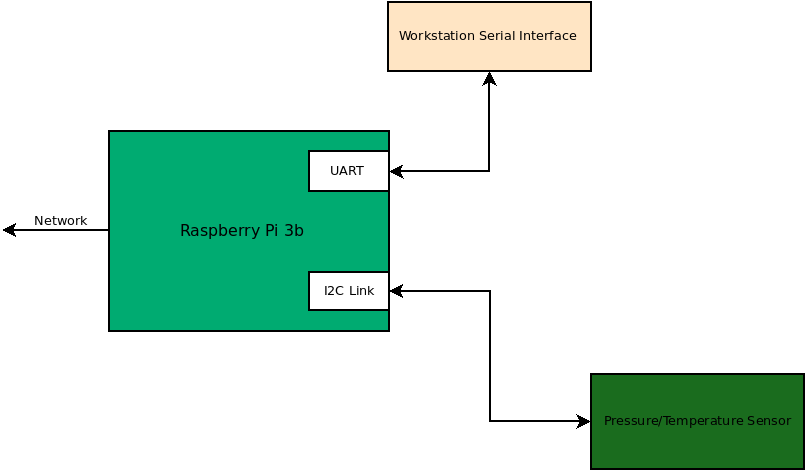
Resources
- I2C Introduction Lecture
- Raspberry Pi I2C Tools
- ST LPS331AP Pressure Sensor Datasheet
- Pololu LPS331AP Carrier Board
- Python Classes
Bread Board
As part of your kit, you have been provided with ST LPS331 AP pressure sensor on a carrier board that is plugged into a breadboard. It is important to rememeber how a breadboard works.
In a breadboard the horizontal holes are connected in groups of 5 pins. There is a divider in the middle of the board that separates the rows two disconnected segments. Along the sides of the boards there are two columns (2 on each side) that are connected vertically. These columns are typically used to route power and ground. Since the P1 circuit is relatively simple, these columns will be unused in this project.

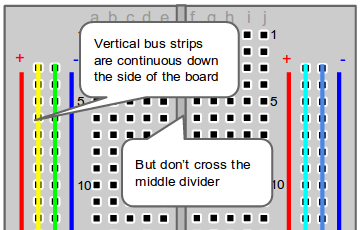
Wiring the Pressure Sensor Board
In this section, you will use the provided wires to connect the pressure sensor to the raspberry pi.
Important: Remove the usb power plug from the raspbery pi before starting the wiring. If you make a mistake with the power on, there will be no time to correct it before damage occurs
While the I2C connection to the sensor is only two wires, power and ground need to also be provided from the raspberry pi. In this case, you will also need a wire connecting the CS pin on the sensor to its own VDD output. This is to enable I2C communication instead of SPI.
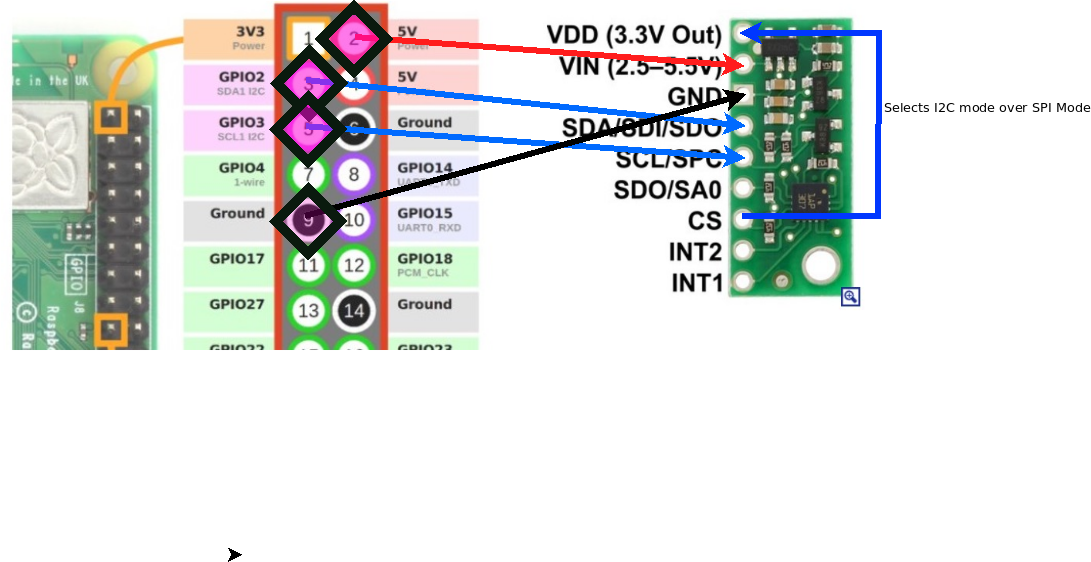
Raspberry Pi I2C Setup
You can go ahead and power your raspberry pi board and login. Before we get to interacting with the sensor, we will need to confirm that the raspberry pi can see the sensor. We will use the utilities i2cdetect and i2cdump to interrogate the sensor.
The wiring that was completed in the previous section attached the sensor to I2C1 of the raspberry pi. The fact that it is on I2C1 will be important in the call to the utilities.
To determine all of the devices that are connected to the I2C1 device, you can use the utility i2cdetect.
Reading the whoami register from the sensor
Now that the sensor is connected and talking to the raspberry pi, we can focus on writing a python program to pull data from the sensor. The following is a small program that reads a register from the sensor.
#!/usr/bin/env python3
import smbus
# Open I2C port 1
bus = smbus.SMBus(1)
# Read register 0x0f from the device at address 0x5d (recall address from i2cdetect)
data = bus.read_byte_data(0x5d,0x0f)
if (data == 0xbb):
print("Found Sensor")
else:
print("Received %d from the sensor"%(data))
bus.close()
This program relies on the python module smbus. The documentation for this function can be located in the terminal by typing “pydoc smbus”. This will list all of the functions of the SMBus class defined in this module.
The program first creates an SMBus object named bus. This object controls I2C bus 1.
With the bus object, the program can then read and write from devices on the bus. This is what occurs when one byte is read from address 0x0F inside the pressure sensor (i2c address 0x5d). From the LPS331AP Pressure Sensor Datasheet Section 6, this address is the whoami register. This register alway returns a 0xbb. This is type of whoami register is typical from a sensor. This allow communication to validated and the specific chip identified.
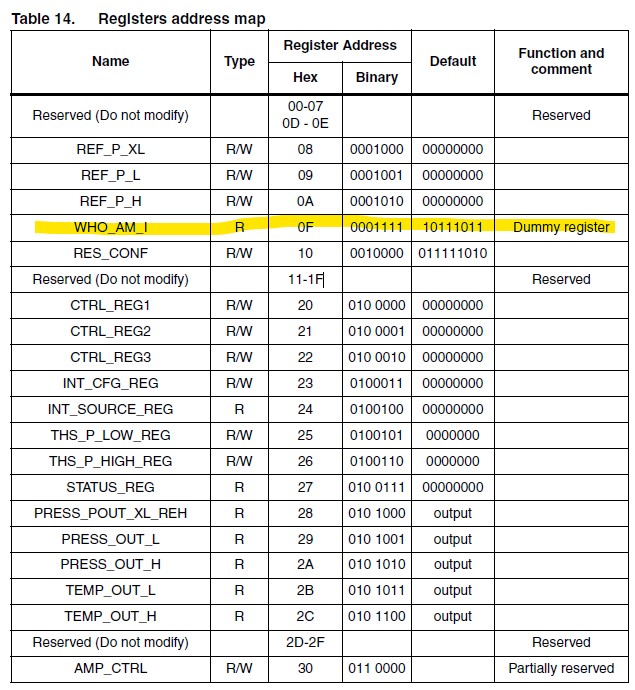
Sampling the pressure and temperature
The LPS331AP pressure sensor wakes up with the sensors disabled. This is a feature driven by low power systems. Typically only communication is enabled initially. To enable the other portions of the chip, a bit typically needs to be set in a control register.
In reading through the Datasheet, you might have noticed that the sensor can be enabled through Control Register 1 bit 7.

To cause the sensor to sample the pressure and temperature, control register 2 bit 0 needs to be written to a one.
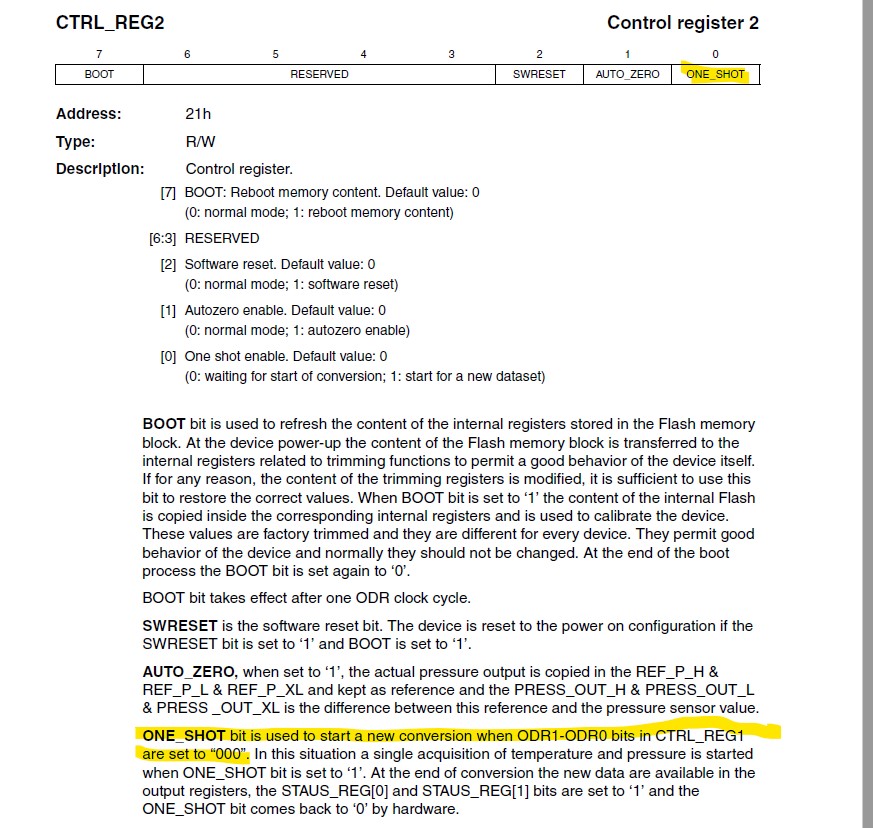
On the setting of control register 2, the sensor will read the pressure and temperature values and store them in registers.

#!/usr/bin/env python3
import smbus
import sys
import time
import numpy as np
# Open I2C port 1
bus = smbus.SMBus(1)
# Pressure Sensor Address
address = 0x5d
# Read, modify, and the write back control register 1.
# Notice that bit 7 is being "or"ed to a value of 1.
ctrl_reg1 = bus.read_byte_data(address,0x20)
bus.write_byte_data(address,0x20,0x80|ctrl_reg1)
# Show the old values for pressure and temperature
press_xl = bus.read_byte_data(address,0x28)
press_l = bus.read_byte_data(address,0x29)
press_h= bus.read_byte_data(address,0x2a)
print("Old Pressure Bytes 0x%02x 0x%02x 0x%02x"%(press_h,press_l,press_xl))
temp_l = bus.read_byte_data(address,0x2b)
temp_h = bus.read_byte_data(address,0x2c)
print("Old Temperature Bytes 0x%02x 0x%02x"%(temp_h,temp_l))
# Write Control Register 2 to cause the sensor to sample
ctrl_reg2 = bus.read_byte_data(address,0x21)
bus.write_byte_data(address,0x21,0x01|ctrl_reg2)
ctrl_reg2 = bus.read_byte_data(address,0x21)
# Poll until the bit that was set control register 2 is cleared.
while (ctrl_reg2&0x01):
ctrl_reg2 = bus.read_byte_data(address,0x21)
# Read the pressure and temperature again to get the new values
press_xl = bus.read_byte_data(address,0x28)
press_l = bus.read_byte_data(address,0x29)
press_h= bus.read_byte_data(address,0x2a)
print("New Pressure Bytes 0x%02x 0x%02x 0x%02x"%(press_h,press_l,press_xl))
temp_l = bus.read_byte_data(address,0x2b)
temp_h = bus.read_byte_data(address,0x2c)
print("New Temperature Bytes 0x%02x 0x%02x"%(temp_h,temp_l))
bus.close()
Creating the lps331 class
Your assignment is to complete the methods in the following class.
#!/usr/bin/env python3
import smbus
import sys
class lps331:
''' allows connection from Raspberry pi to I2C connected lps331 '''
def __init__(self,raspberry_pi_i2c_port=1):
self.i2c_port_number = raspberry_pi_i2c_port
self.bus = smbus.SMBus(self.i2c_port_number)
self.address = self.find_sensor()
if (self.address == -1):
print("Error: could not read from sensor at i2c address 0x5d")
sys.exit()
self.enable_sensor()
def find_sensor(self):
''' read the whoami byte from i2c address 0x5d and confirm to be 0xbb '''
# Return the address if found (0x5d) and 0 if not found
# @@@@ Your Code Here @@@@
pass # if the sensor was not located on either bus, return -1
def i2c_address(self):
return(self.address)
def sample_once(self):
''' Cause the sensor to sample one time '''
# @@@@ Your Code Here @@@@
pass
def read_temperature(self):
''' Sample, read temperature registers, and convert to Degrees C '''
tempC = 0
# @@@@ Your Code Here @@@@
return(tempC)
def read_pressure(self):
''' Sample, read pressure registers, and convert to inhg '''
press_inhg = 0
# @@@@ Your Code Here @@@@
return(press_inhg)
def enable_sensor(self):
''' Turn on sensor in control register 1'''
# @@@@ Your Code Here @@@@
pass
def disable_sensor(self):
''' Turn off sensor in control register 1 '''
# @@@@ Your Code Here @@@@
pass
def close(self):
''' Disable the sensor and close connection to i2c port '''
self.disable_sensor()
self.bus.close()
if __name__ == "__main__":
sensor = lps331(1)
print("Temperature = %0.2f Deg C "%(sensor.read_temperature()))
print("Pressure = %0.2f inHg"%(sensor.read_pressure()))
sensor.close()
To test your code, we will instantiate an lps331 object from your code. Each method will be tested against a working version of the code.
What to turn in (DUE 1/26 11:59PM)
1) Working code:
- You and your partner should work to complete this module and commit it to your repository. When you are satisfied with the code, go to canvas and submit the commit link.
- You and your partner should also demonstrate your working code (printing the temperature and the pressure) to one of the TAs present. Alternatively, a video of your functioning code may be submitted to canvas, but this method of submitting is not recommended unless you are sure of the accuracy of your code.
2) Individual Contributions:
-
List down the accomplishments of each member of the group. You should use a
MarkDowntable for this purpose. The table should be formatted similar to the following:Date Time Contributor Accomplishment 1/11/2023 3:15 pm Malintha Completed the sensor enabling code 1/11/2023 4:30 pm Matteo Completed the sensor temperature sampling code 1/11/2023 4:45 pm Caleb Converted the sensor readings to standard units.
Both team members should submit to the canvas.
